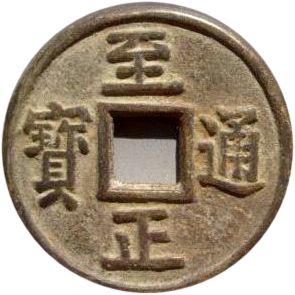Volume One
Ancient and Medieval States
Background
The Mongol Empire
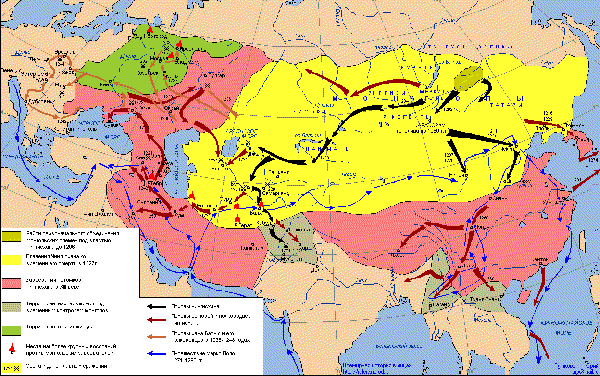
Mongol Conquests
By raids, treaties, invasions and annihaltion of resisting states, the Mongols created the largest land-based empire of all time. Once established, the Mongol Empire facilitated trade across Asia, and allowed Europeans contact with the more prosperous and materially advanced nation states of south and east Asia, but the initial effect was horrific slaughter and the spread of bubonic plague.
Genghis Khan first unified the Mongol and Turkic tribes, absorbed the Uighur Qocho kingdom, and then conquered the Qara Khitai and Khwarazmian dynasty. Cities were given an uncompromising ultimatum: submit or be destroyed. The only state to successfully resist the Ghengis and his descendents were the Mamluks of Egypt, who defeated a young and inexperience Mongol commander at Ain Jalut in 1260, and the Singhasari kingdom of Java in 1293. All otherwise were subdued, often with near-total loss of life: Bukhara (1220), Yinchuan of the Western Hsia (1227), (1258), Kiev (1237), Hungary (1241), Baghdad (1258), Xiangyang (1270), Vijaya of Champa (1282) to mention only a few. The endurance and speed of Mongol cavalry, their exhaustive military intelligence, the tactical battlefield skills and the siege tactics they gradually acquired made the Mongol advance unstoppable, and much of Europe was saved only by the return of Mongol leaders for the kurultai on the death of Ogedei Khan in 1242. {1-4}
Ilkhans (1256 — 1353)

Ilkhanid: Baydu (1295). Ar Dirhem. Minted Tabriz in AH 694 AH. Weight: 2.54 gm. Diameter: 22mm Album 2165, Diler BA-250.
Obverse: in Mongolian: Qaghanu / nereber / Baydu-in / deledkegülüg. (Of the Great Khan / in the name / of Baidu / caused to be struck).
Reverse: Kalima in ornate kufic Arabic within square: la illah illa / Allah Mohammad / rasul Allah. (There is no God but / Allah. Mohammad /is the messenger of God.) Zuriba Tebrez (Struck in Tabriz) in outside corners. {9-12}
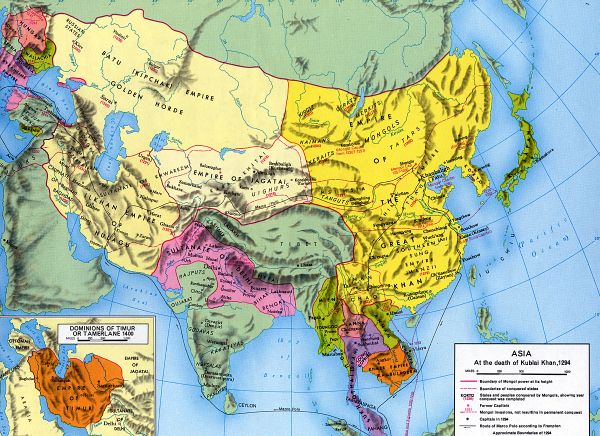
The Mongol empire was split into four khanates after its founder's death. The Ilkhanate centered on Persia but included present-day Iran, Iraq, Afghanistan, Turkmenistan, Armenia, Azerbaijan, Georgia, Turkey, and western Pakistan. The founder was Hülegü Khan, grandson of Genghis Khan, who conquered Baghdad and so ended the Abbasid caliphate in 1258. The Mongol advance was checked by the Mamluks at Ain Jalut in 1260, however, and, after widespread devastation, the Mongols settled to rule their territories, eventually giving prosperity and a cultural renaissance to the region. Initially the Mongols were shamanists, then Buddhists and finally, under Ghazan, converted to Islam. Though the Mongols practised religious tolerance, Christian and Jewish subjects lost their equal status with Muslims, and again had to pay the poll tax. Buddhists had to convert to Islam or face expulsion. Ghazan fought the Mamluks for Syria, and his brother Öljeitü conquered Gilan on the Caspian coast, where his magnificent tomb in Soltaniyeh remains the best known monument of Ilkhanid rule in Persia. Hostilities thereafter were minor, and efforts to find European allies in the war against the Mamluks came to nothing. The khanate disintegrated rapidly after Abu Sa'id's death in 1335, splitting into several rival successor states, most prominently the Jalayirids. The last of the Ilkhan pretenders was assassinated in 1353, and Timur later included the Jalayirids in his own empire.
A unified Mongol Empire furthered trade and commerce across Asia, which was much helped by the Mongol dynasty established in China. Movements of people, commodities, and ideas across Asia benefited both countries, particularly in cartography and astronomy, medicine, agriculture, textiles, food, and printing. Crops were introduced from the Islamic world into China, and culinary influences went in both directions. Hülegü supported the Shi'ite savant Nasir-al-Din in the construction of an astronomical observatory at Mara'a, and surrounded himself with scholars from different religions and cultures The massive palace complex at Takt-e Solayman built during the time of Abaqa was lavishly adorned, and the later Ilkhans combined Islamic and Mongol motifs on coins, inscriptions, building projects, letters, and orders. Ghazan Khan made important agricultural and fiscal reforms in the 1295-1304 period. Persian historians moved from writing in Arabic to writing in their native Persian. Independent of Europe, the rudiments of double-entry book-keeping were practised under the Ilkhanate, and this ' merdiban' was then adopted by the Ottoman Empire. Finally, the Ilkhanate renewed the concept of a Persian state, which gave credibility to the Safavids and ultimately the modern country of Iran. {5-8}
Conquest of China
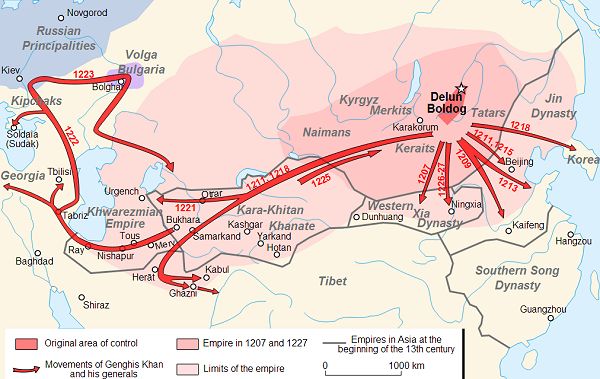
The Western Hsia and Jin dynasties fell comparatively quickly to the Mongols but Song China put up a protracted and ferocious resistance. Kublai was elected great khan in 1260 but first had to cope with disaffected relatives. The Chinese terrain was unsuitable to cavalry warfare; the cities were strongly fortified, and the Song had a large navy. But Mongol armies were converging on Hangzhou by 1275, and the city fell the following year. The boy emperor was sent to Kublai, who had him brought up as a priest. Canton held out for another year, and the last of the Song pretenders was drowned by his attendants in 1279. {13-14}
Yuan Dynasty of China (1279-1368)
The Yuan dynasty largely took over the Song administration, but the examination system was discontinued. Promotion was no longer by merit, and indeed the Chinese found themselves at the bottom of society, beneath foreigners, Mongol citizens and members of the khan's extended family. Kublai was an exceptionable able, wise and benevolent ruler, but later emperors were more puppets controlled by rival Mongol factions. Some were drunkards or worse, though the administration, often staffed with foreigners, generally held firm. Southern China was in the hands of warlords after 1350, however, and the last emperor (who issued an extensive coinage, perhaps to give confidence to the peasant classes) sunk into debauchery and Lamaist bigotry. Insurrections proliferated, coalesced around the son of a poor farm labourer, and marched on Peking. Toghan Temur and his court fled to Mongolia in 1368, and the strongly sinicized, inward-looking Ming dynasty had begun. {15-19}
Chinese historians do not remember the Yuan dynasty with much affection, but Kublai and his grandson (Temur Oljeitu) were effective and conscientious rulers. Kublai introduced a postal service, extended the Grand Canal, fixed prices and made provision for the poor and for times of hardship. The merchant class prospered, the country was more open to foreign influences, and entertainment popular with the lower orders came into prominence with novels and plays. {15-19}
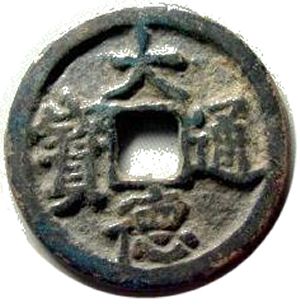 | Emperor Cheng Zong (Temur Oljeitu) 1294-1307Ae One cash. Obv: Da De tong bao Rev: plain(Hartill 19.29) |
Coinage was restricted, however, and Yuan China generally used paper denominations, even for small transactions. Detailed records exist, but many matters are still unresolved: the relationship between two types of paper money (Exchange Certificates and Original Treasure Certificates), for example, the real exchange rate between copper cash, silver ingots and paper money, and whether there was indeed a consistent money policy at all. Coins were issued sporadically in small quantities, often in iron as well, and then withdrawn, with heavy penalties applying to anyone still hoarding cash of any sort. Sometimes the bans applied to gold and silver usage too, though these were generally short-lived. Certainly there were periods of rapid inflation, which added to the peasant's hardships and then social unrest, but the common explanation that notes were over-issued and not backed by silver and gold reserves may overlook other factors: possibly increasing social chaos, military funding and a loss of confidence in fair and efficient government. {20}
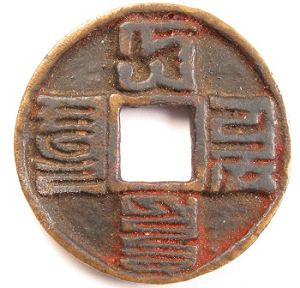 | Emperor Wu Zong (Khaishan) 1308-11Fe One cash. Obverse: Ta Uen tung baw in Mongolian (Da Yuan tong bao in Chinese). Rev: plain(Hartill 19.44 var.) |
Unlike the Ilkhans, who converted to Islam, the Yuan Mongols did not identify with native customs. Coins issued by the Mongols did employ Chinese on occasion, however, so that there exist coins wholly in the Mongolian Phags-pa script, coins wholly with Chinese legends, and coins with both scripts, all issued in a great variety of coin sizes and calligraphic styles. Most of the pieces are scarce or rare, and badly cast, which makes deductions about their use rather hazardous. Peng Xinwei suggests that few of them actually circulated as money while Yuan government was effective, i.e. in the north of China. Matters were more chaotic in the south, however, particularly in late Yuan times, and peasants may well have used copper cash, probably hoarded Tang and Song pieces, which also flooded out of the country to be widely used in Java and Japan. {20}
| | Emperor Shun (Toghon Temur) 1333-68Ae 10 cash.Obv: Zhi Zheng tong bao |
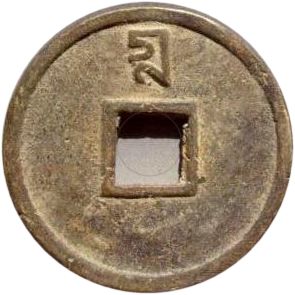 |
Hartill 1915 var.Diameter 42 mm. |
There are also Yuan gold coins, probably not intended to circulate, and silver, which perhaps did. Silver indeed formed the measure of value, just as copper cash had in Song and Tang times, and measures of weight before. Silver was given as the khan's annual gifts to the imperial clan and their guards. Silver was used to purchase horses, and coins were minted depicting a man on horseback, or an animal to represent the Chinese year. Silver was also cast into ingots of 12, 25 and 50 ounces weight. More particularly, silver was used as a store of value, and a backing for the extensive paper currency. {20
The Mongols began issuing paper money before completing the conquest of China, perhaps as substitutes for the Jin paper currency, which had entirely collapsed. Under Kublai, three kinds of paper money were issued: 'Original Treasure Exchange Certificates', 'Original Treasure Certificates' and 'Silver Money'. Relations between the first two are not clear, though the redemption price in silver and gold was stipulated. The third appears never to have circulated, and was therefore a measure of value only. Treasure Certificates were issued in quite small denominations: from 5, 10, 20, 30, 50 100, 200, 500 cash to 1 (probably 1000) and 2 strings of cash. Monetary reform came in 1276, when the Mongols finally took control of the rich and populous region south of the Yangtze: pre-existing paper money and cash coins were recalled and replaced by paper money printed from copper plates. In 1309, Silver Certificates were issued for 13 denominations (from 1/1000 to 2 ounces of silver), and the ban on the use of older cash coins relaxed. The Emperor Wuzong died two years later, however, and these Silver Certificates were discontinued by the new Renzong emperor. Gold and silver was brought back into favour, provided it was not circulated as money or exported beyond China's borders. Policies changed again — this is only the briefest summary of Peng Xinwei's detailed accounts — in 1350 when one string of 'Zhizheng Certificates' were equated with 1,000 copper cash, or two strings of 'Zhiyuan Certificates'. Whatever might be said of the effects, the Yuan government did not issue paper money ignorantly, but clearly experimented to find the optimal arrangements. Indeed there were many monetary studies of a theoretical and practical nature, some with histories of Chinese money use. {20}
At the other end of scale, remote areas used commodity money: cowries in Yunnan, and salt bricks in the Xikang-Tibet region. A string of eighty cowries was worth 0.12 ounces of silver, where eight ounces of silver were worth one ounce of gold. But as the government took twenty cowry strings to be worth 0.1 ounce of gold for taxation purposes, exploitation of the peasant class was evident even here. {20}
Paper currency was also tried in Ilkhan Persia, incidentally, in 1294, and these certificates also bore Chinese characters: an illustration of the open nature of Mongol rule across Asia. {20}
Yuan coinage is even more complicated, much more than it is possible to summarize here, and students will need to consult one of the many cash coin catalogues. {21}
The Mongols initially issued paper money cautiously, mindful of Jin inflation (where, in 1234, reminiscent of Weimar hyperinflation seven centuries later, one hundred strings of paper money were needed to buy one bowl of noodles). The first paper money was 100% backed by gold and silver reserves. Issues were gradually increased to meet the cost of war against the Song, but increased even further after victory, when copper coinage also was banned lest it prove more popular than paper money and cause paper money inflation. There were still wars to be fought overseas, however, and a black market operated for gold and silver, itself reducing the effective value of paper money. Expenditures were large. For the first seven weeks of 1287, for example, paper money to the tune of 500,000 ingots (25 million strings) was issued, i.e. ten times the annual issue of the tianboa era (Tang: 742-46 AD). Some 23 years into the Yuan dynasty, and paper issues were reaching 2 million silver ingots. The native Chinese found themselves hard pressed from both sides: from a depreciating currency and a several-fold rise in prices. As the dynasty continued to send its ships and armies abroad, there were rebellions in south-west China, which the government struggled to contain. Yet paper issues continued to increase, to the equivalent of 36 million ingots in 1310, for example. Later, in middle Yuan times, paper money was not only extensively counterfeited, but issued under private licence by individuals who grew immensely wealthy but further undermined the system. The price of food and drink in 1287 had risen several dozen times higher than those prevailing twenty years before. Salt, essential to an inland people, and from which the government drew much of its tax revenues, was 500 times higher in price than during Tang dynasty times. Adding to the chaos was a tendency to hoard money until paper money shortages reversed inflation, followed by a sudden divestment when it became apparent that the government would print even more: a flood of unwanted notes immediately sent prices soaring. When famine struck north-west China in 1329, unscrupulous officials set their own redemption rates for 'Certificates'. {20}
And so it went on: as in the late Roman Empire, the army had to be paid. And Yuan China was always a military state, one imposed on the Chinese and to which they felt no loyalty. A Yunnan uprising in 1341 spread to over 300 locations. More 'Certificates' were issued. In 1348 Fang Guozhen rebelled in Taizhou, and in 1351 there were rebellions led by equally charismatic figures: Han Shantong, Lui Fatong and Xu Shouhui. The price of rice climbed still further, to 20 strings a picul, and a host of rebels appeared in the Yangtze and Huai regions. Huangzhou itself was attacked. The Yuan generals led their armies out, but these underpaid and demoralized soldiers deserted to the Red Turbans and other rebel groups. The country was then beyond governing, and the Mongol interlude was over. {20}
Conquest was in the Mongol blood, but unremitting military expenditures led to hyperinflation, peasant uprisings and overthrow of the dynasty. As noted in the Wang Mang episode, an orderly currency denotes orderly government, and that need for order applies even today, obsessively so in post-industrial states. Unlike the Qing dynasty rulers, the Mongols did not identify with the ideals of a bureaucratic state, and this failure, which is reflected in their coinage, lost them effective government and then, in ninety years, the Mandate of Heaven. There are many ways of governing a country, each with their advantages and disadvantages, but all require confidence in their administrations and identity with their citizens' underlying beliefs.
Timur (1370-1405)
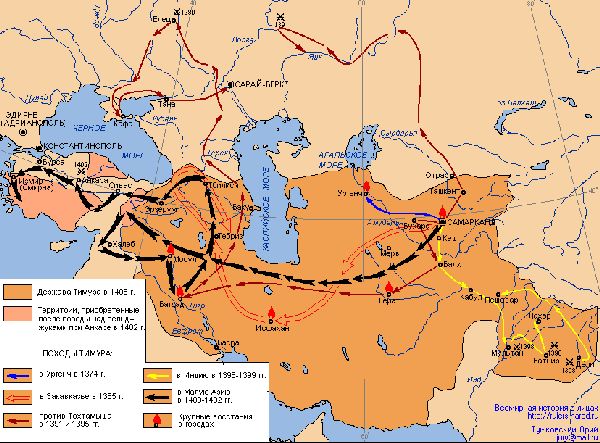 The Mongols were only one of the many steppe empires that have come and gone across the millennia. When well known to history it is generally because of reports from neighbouring and literate states — by the Scythians, Huns, T'u-chuë, Uigur, Khitan, Mongolians, Timurids, Shaybanids, Golden Horde, Jagataites, Manchus — but some invaders also merged with conquered peoples to create important civilisations in their own right: the Seljuks, Sultans of Delhi, Mongolians and Manchus. {22}
The Mongols were only one of the many steppe empires that have come and gone across the millennia. When well known to history it is generally because of reports from neighbouring and literate states — by the Scythians, Huns, T'u-chuë, Uigur, Khitan, Mongolians, Timurids, Shaybanids, Golden Horde, Jagataites, Manchus — but some invaders also merged with conquered peoples to create important civilisations in their own right: the Seljuks, Sultans of Delhi, Mongolians and Manchus. {22}
Timur (known to us as Tamerlane) created the last great Asian empire. In 35 short years he conquered Persia, the territories of the Golden Horde, the Sultans of Delhi and the Ottomans, and was embarked on a conquest of Ming China when he died in 1405. Gradually reducing in size, Timur's empire was ruled by his successors, the Timurids: a dynasty of some intellectual and cultural brilliance, from which descended Babur, the founder of the Mughal Empire. Timur's passion was for architecture, but while he greatly embellished Samarkand, he also destroyed Khiva, Baghdad, Damascus, Delhi and host of other cities. {23-25}
 | Ar Tanka of Timur (771-807 AH / 1370-1405 AD |
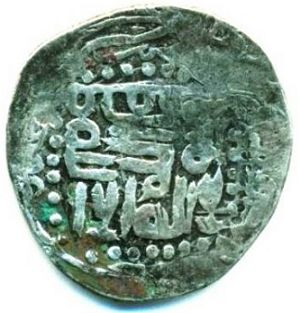 | |
The Timurids did not last long. The empire split into Transoxania and Persian sections in 1449, and decayed irretrievably into petty kingdoms during the 1451-69 reign of Abu Sa'id Mirzi, for reasons that are obvious. Timur, and more particularly his successors, created a magnificent court that fostered Persian culture, but the empire was brutally conquered by the sword, had little coherence otherwise, and was administered largely by taxation. {23-25}
References and Further Reading
Need the 25 references and 8 illustration sources? Please consider the inexpensive ebook.

